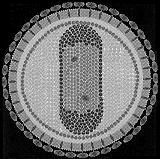
Back Infekční anémie koní Czech Ansteckende Blutarmut der Einhufer German Anemia infecciosa equina Spanish Anémie infectieuse équine French Lovak fertőző kevésvérűsége Hungarian Anemia infeksius kuda ID Anemia infettiva equina Italian 馬伝染性貧血 Japanese Инфекциялық анемия Kazakh Anemia Infetiva Equina LMO
| Equine infectious anemia virus | |
|---|---|

| |
| Virus classification | |
| (unranked): | Virus |
| Realm: | Riboviria |
| Kingdom: | Pararnavirae |
| Phylum: | Artverviricota |
| Class: | Revtraviricetes |
| Order: | Ortervirales |
| Family: | Retroviridae |
| Genus: | Lentivirus |
| Species: | Equine infectious anemia virus
|
Equine infectious anemia or equine infectious anaemia (EIA), also known by horsemen as swamp fever, is a horse disease caused by a retrovirus (Equine infectious anemia virus) and transmitted by bloodsucking insects. The virus (EIAV) is endemic in the Americas, parts of Europe, the Middle and Far East, Russia, and South Africa. The virus is a lentivirus, like human immunodeficiency virus (HIV). Like HIV, EIA can be transmitted through blood, milk, and body secretions. Transmission is primarily through biting flies, such as the horse-fly and deer-fly.[1] The virus survives up to 4 hours in the vector. Contaminated surgical equipment and recycled needles and syringes, and bits[2] can transmit the disease. Mares can transmit the disease to their foals via the placenta. The risk of transmitting the disease is greatest when an infected horse is ill, as the blood levels of the virus are then highest.
- ^ "Equine Infectious Anemia: Introduction". The Merck Veterinary Manual. 2006. Retrieved 2007-06-23.
- ^ Equine Infectious Anemia (EIA) Archived 2009-07-27 at the Wayback Machine, North Carolina Department of Agriculture and Consumer Services, retrieved December 19, 2008.